Once in a blue moon, or maybe a bit more often, I opportunistically photograph a full moon. I almost never plan to do so; all of my photos here were taken from where I was at the time. I did not travel specifically to get a moon photo. Here are some thoughts and ideas if you wish to plan and photograph a full moon or even a waning or waxing moon. And be prepared, we are in for two blue moons in a row.
By the way, what is a blue moon and what is the correct exposure to show detail in a full moon no matter what color it is? Well, the modern definition is a blue moon is the second full moon in a given month, as we will have next month. So if you photograph the full moon at the end of August you can claim that you photographed a blue moon. However, an older definition holds that a blue moon is the third full moon in a season with four full moons. Since there are 4 seasons and normally 12 lunar cycles each year, there are normally three full moons in each of spring, summer, autumn, and winter. But things are not this in sync so occasionally a thirteenth full moon sneaks in and one season has four full moons. Even though there will be two full moons in August, 2012 (and September, 2012!), there will not be a seasonal full moon until August, 2013.
More importantly for photographers, what is the correct exposure for a full moon if you want detail and not a white blob? Ever hear of the Sunny-16 rule? Before and even after the advent of light meters it was used to estimate the correct exposure for a scene lit by the sun on a sunny day. It states that the correct exposure is an aperture of f/16 and shutter speed of 1/ISO. So just set your camera to manual exposure, the aperture to f/16, and the shutter speed to the reciprocal of the ISO you are using.
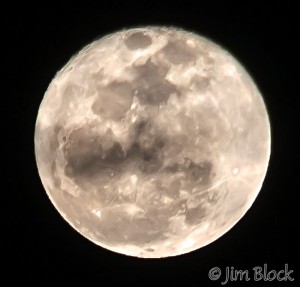
But what of the moon? It is simply an object lit by the sun so this rule also gives the correct exposure for the moon, though not necessarily for anything on earth in the same photo. Some people fudge the rule a bit to get a slightly brighter moon and apply the Moony-11 rule, but either works well. Of course if the sky is hazy you might have to increase the exposure, sometimes quite a bit. This is particularly the case just at moon set or rise when it often has a yellow color from all the atmosphere the light must pass through. Fortunately we now have good ways to check the exposure. And if you are shooting raw you have a much better chance of recovering detail in what would be a blown out (overexposed) moon with a JPEG capture.
If you want to photograph a full moon with something on earth that is not a black shilouttte, when is the best time to do so? It turns out the best times to photograph a full moon is NOT when the moon is full.
As with many photographs it is useful to visualize the photo you would like before you even see what you are going to take a photo of! Galen Rowell called it previsualization and wrote it was the most advanced way of making a photo. In any case it is helpful to think about what you are after and what the photo(s) might look like before you set out to take them.
What are you trying to do? Get a close up of only the moon? Incorporate the moon in a scenic? How big in the image? Foreground a silhouette or with detail? How about the sky? Stars too? Most people want the full moon and some nice, decently exposed, landscape elements too. Perhaps a hillside with an old barn in Vermont.
As I said, the best times to photograph a full moon are when the moon is NOT full. If you want more than a silhouette of the foreground in the photo, a day (or maybe two) before or after the full moon is often best depending if you are a morning or evening person and/or which way you plan to aim your camera. You want the sun to be low in the sky at the same time as the moon so the sun will light the landscape. When the moon is fully full, the sun sets before the moon rises, unless you are in a tall building or on a mountain.
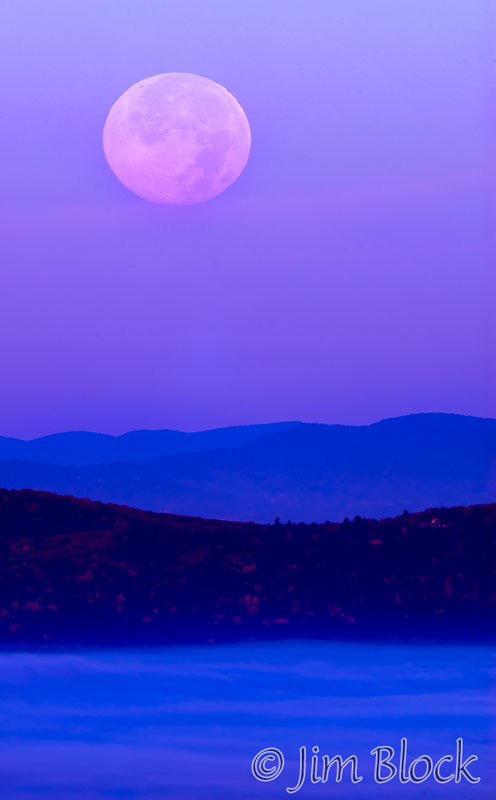
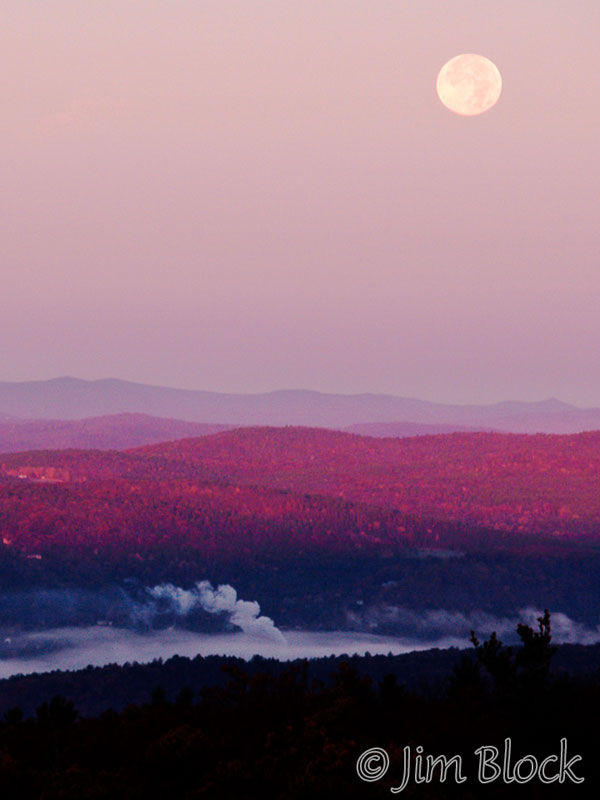
To photograph a landscape to the west, it is best to shoot the day after the full moon at sunrise. This is what I did in the photo on the right above taken from my home in Etna looking over the Connecticut River Valley into Vermont. In it you can see the fall foliage illuminated by the rising sun. The foliage is very red because the particles in the Earth’s atmosphere scatter the shorter wavelengths of the light — the blue hues. When the sun is very low this leaves the longer red wavelengths to pass through. When the sun is high in the sky, blue light from the sun is scattered in all directions on its way to the Earth causing the sky to look blue.
The left photo above shows a setting hunter’s moon over the fog in the river valley at dawn the morning of the full moon. A hunter’s moon is the first full moon after the harvest moon, which is the full moon nearest the autumnal equinox. In both cases above the moon has a hue due to the length of the earth’s atmosphere the light must pass through when the moon is low in the sky.
To photograph a landscape to the east, plan your shot for the day before the full moon at sunset. At these times the moon will rise or set as the sun sets or rises, and you can get an exposure for the landscape that is close to the right exposure for the moon. And there will be some color in the sky which is normally a plus.
Below is a photo to illustrate this. The moon looks full but it really isn’t. The photos was taken out my Danfe Lodge window looking east at one of the most beautiful mountains in the world at 5:13 PM from Khumjung, Nepal on November 1, 2009, the day before the full moon. The setting sun is illuminating the top of Ama Dablam and providing nice light on the rest of the scene. There is detail in the moon.
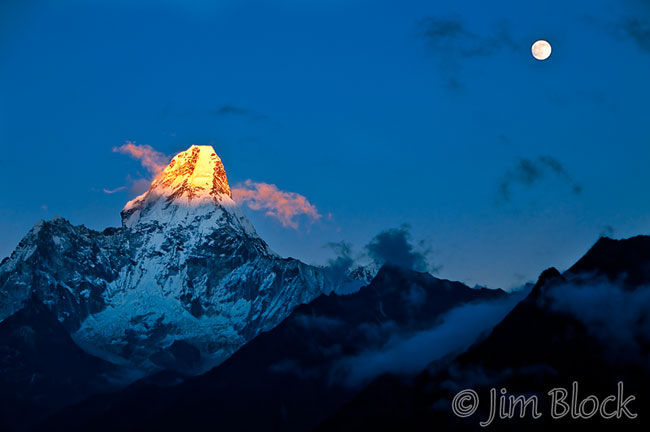
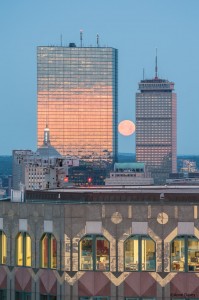
Sometimes when you are working another subject the moon appears at just the right time and location. Of course you need to be awake and prepared. Anne Davey, who has taken a number of courses with me but was a good photographer and an experienced Photoshop user before she started them, is completing a 3 year project to photograph buildings in Boston. Last year she did a show at DHMC with large prints of her Boston photos that she expertly framed herself. Just over a week ago, on July 3 she took the photo on the right at around 5 AM of a moon setting over Boston. Anne wrote to me:
“I believe that I stopped breathing for an instant when I saw the moon peek out from behind the Hancock Tower while I was shooting. Definitely a case of being in the right place at the right time. I took several shots while I waited for the moon to fill the space between the buildings.”
If you overexpose a moon at dawn or sunset it can resemble the sun behind a thin cloud or in fog. That is what happened with the photo below of the setting moon taken in Arizona December 24, 2007 at 7:06 AM, the morning of a full moon. The moon is overexposed because I exposed for the landscape that was not yet lit by the rising sun.
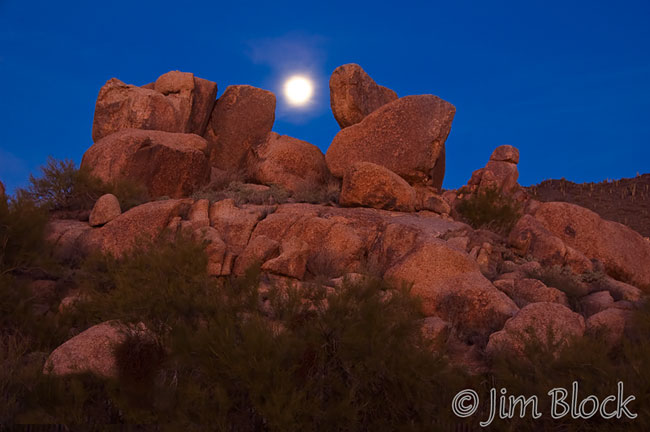
Often when you have a chance to photograph a full moon your timing is wrong or the environment won’t cooperate or one of many things that makes photography so challenging and rewarding happens. Often there are three problems to confront. First you want to get a lot in the foreground but then the moon is too small. Second, since your timing is wrong, the moon is too bright for the foreground. Third, since you are pretty close to the foreground and the moon is pretty far away, you have a depth of field issue. The way to solve these problems is to do what photographers have done for years with the moon—double expose. But now it is easier with Photoshop because you don’t need to get both images on the same piece of film or be a darkroom wizard. You can simply take two photos and combine them.
I’m certainly not condoning “cheating”, especially not in nature photos. But photography as an art is perhaps another matter. Sometimes combining multiple images can better express what you saw or felt. After all no photo ever is a completely accurate depiction of reality. In any case, it is up to the individual photographer to decide how many of the image optimization and enhancement tools he or she wishes to employ.
Earlier this year while in Nepal on a month long trek we were honored by a puja ceremony at Khari Gompa, a Buddhist monastery in Thamo led by Khari Rimpoche. This was especially significant for the nuns since it was the night of the full moon and they were honoring a good friend, one of my travelling companions. But since the ceremony took place around sunset, I was not able to photograph the moon until it was high in the sky. There it was when I looked up at the newly painted entrance of the prayer hall, but all of the challenges mentioned above were also present. So I took two photos and the result is below.
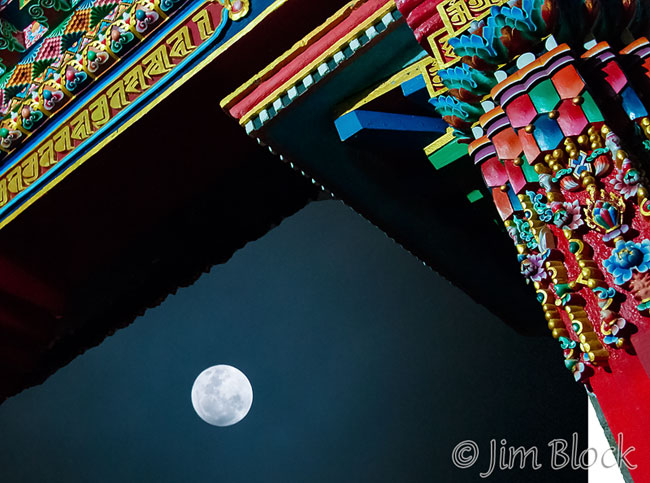
The moon shown here is in the same place it was in the image of the prayer hall doorway, but it was overexposed and too small. It was a simple matter to drop the second exposure of the moon into the sky region of the first.
How might you make a non-full moon look full and also show the stars? Shoot at night and overexpose the moon. You won’t get detail in the moon but you can produce an image where the moon resembles the sun in a dark sky with stars. The photo below was taken from the same window as the 2009 image at the top of this blog but at 4:25 AM on April 17, 2012, looking east at Ama Dablam (which is at the far left) when the moon was only 4 days away from new. The faint glow at the left is the rising sun which will rise to the left of Ama Dablam.

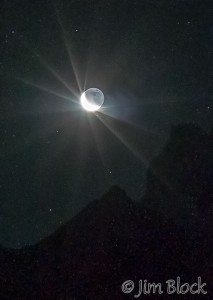
To the right is a piece of the right side of the same scene photographed 3 minutes earlier but exposed and processed to reveal what the moon really looked like. By the way, why can we see the dark side of the moon? What is the light source for it? Stop reading and figure out for yourself. I’ll give you a hint, the phenomena is called “earthshine”. If that isn’t a big enough hint, the answer is at the end of this piece. You can get great photos of earthshine if you photograph the moon a few days before or after a new moon. The four days of this photo were a bit too long before the new moon, but this was just an opportunistic shot.
Photos of earthshine when the moon is just a sliver can be quite dramatic. The first photo below shows the waxing moon near Mount Ascutney in Vermont at sunset. The second photo below shows a conjunction of the moon, Venus, and Jupiter.
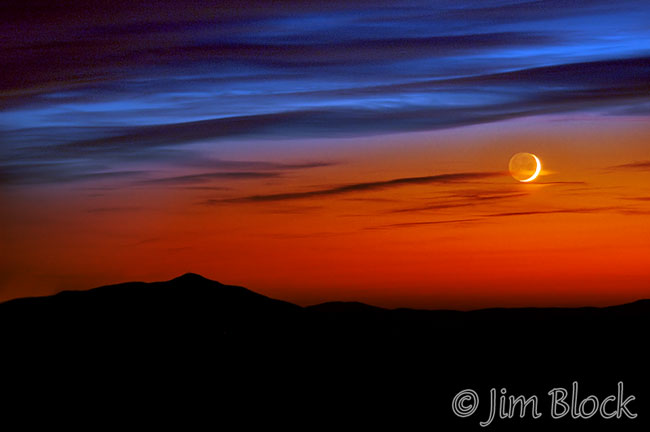
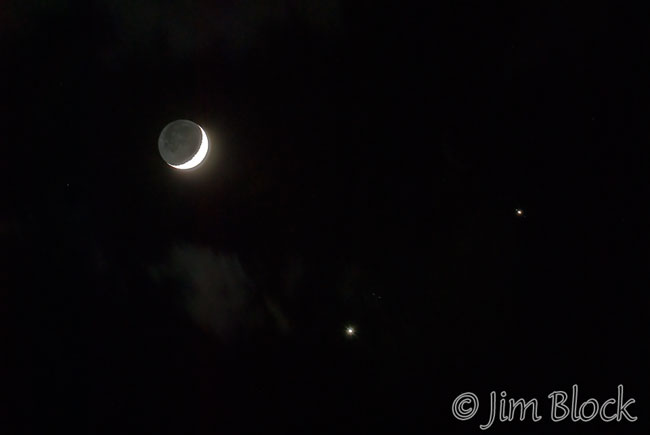
You can read Part 2 of this piece by clicking HERE.
If you are interested in Photography you might enjoy visiting and “liking” my more-active Facebook photography page Tug Hill Photography.
Earthshine is when the dark side of the moon is lit by light from the sun that is reflected off the earth. Any questions? Send me an email.
